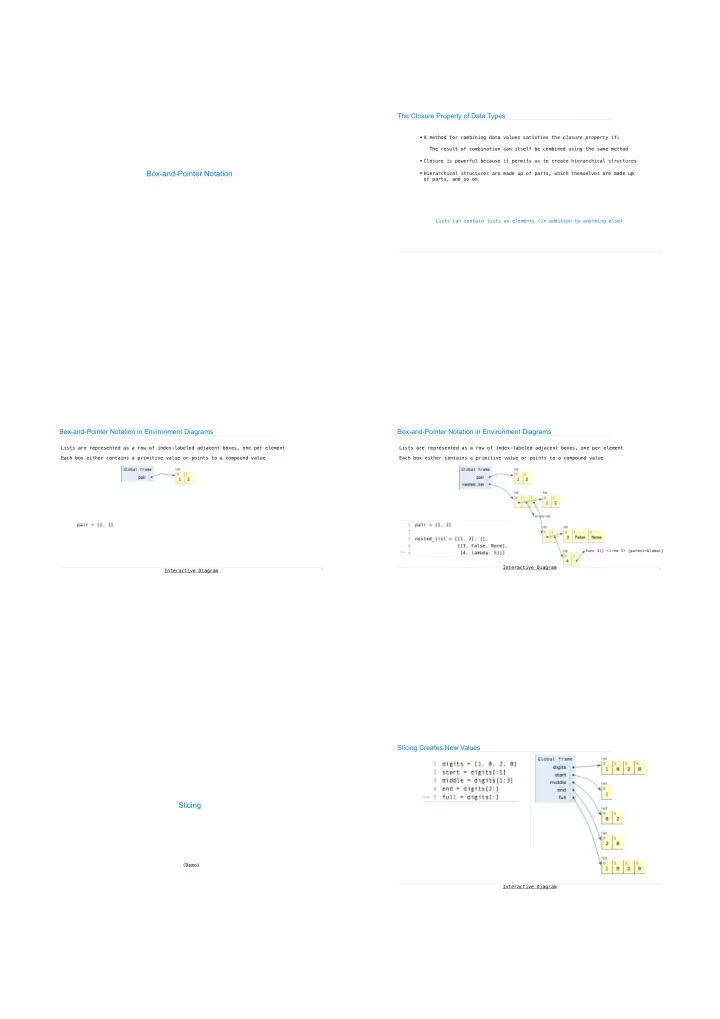

The Closure Property of Data Types • A method for combining data values satisfies the closure property if: The result of combination can itself be combined using the same method • Closure is powerful because it permits us to create hierarchical structures Box-and-Pointer Notation • Hierarchical structures are made up of parts, which themselves are made up of parts, and so on Lists can contain lists as elements (in addition to anything else) 4 Box-and-Pointer Notation in Environment Diagrams Box-and-Pointer Notation in Environment Diagrams Lists are represented as a row of index-labeled adjacent boxes, one per element Lists are represented as a row of index-labeled adjacent boxes, one per element Each box either contains a primitive value or points to a compound value Each box either contains a primitive value or points to a compound value Interactive Diagram Interactive Diagram 5 6 Slicing Creates New Values Slicing (Demo) Interactive Diagram 8
Sequence Aggregation Several built-in functions take iterable arguments and aggregate them into a value • sum (iterable[, start]) -> value Return the sum of an iterable of numbers (NOT strings) plus the value of parameter 'start' (which defaults to 0). When the iterable is empty, return start. Processing Container Values • max (iterable[, key=func]) -> value max (a, b, c, ...[, key=func]) -> value With a single iterable argument, return its largest item. With two or more arguments, return the largest argument. • all (iterable) -> bool Return True if bool(x) is True for all values x in the iterable. If the iterable is empty, return True. 10 Tree Abstraction Nodes Root of 3 Root branch Label values Branch 1 2 0 1 1 1 Trees Leaf 0 1 Recursive description (wooden trees): Relative description (family trees): A tree has a root and a list of branches Each location in a tree is called a node Each branch is a tree Each node has a label value A tree with zero branches is called a leaf One node can be the parent / child of another People often refer to values by their locations: "each parent is the sum of its children" 12 Implementing the Tree Abstraction Implementing the Tree Abstraction def tree(label, branches=[]): def tree(label, branches=[]): • A tree has a label • A tree has a label Verifies the return [label] + branches for branch in branches: value and a list of value and a list of tree definition branches assert is_tree(branch) branches def label(tree): return [label] + list(branches) return tree[0] 3 3 def label(tree): Creates a list from a sequence def branches(tree): return tree[0] of branches return tree[1:] 1 2 1 2 def branches(tree): Verifies that return tree[1:] tree is bound 1 1 1 1 to a list def is_tree(tree): >>> tree(3, [tree(1), >>> tree(3, [tree(1), if type(tree) != list or len(tree) < 1: ... tree(2, [tree(1), ... tree(2, [tree(1), return False ... tree(1)])]) ... tree(1)])]) [3, [1], [2, [1], [1]]] for branch in branches(tree): [3, [1], [2, [1], [1]]] if not is_tree(branch): def is_leaf(tree): return False return not branches(tree) (Demo) return True 13 14
Tree Processing Uses Recursion Processing a leaf is often the base case of a tree processing function The recursive case typically makes a recursive call on each branch, then aggregates def count_leaves(t): Tree Processing """Count the leaves of a tree.""" if is_leaf(t): return 1 else: branch_counts = [count_leaves(b) for b in branches(t)] return sum(branch_counts) (Demo) (Demo) 16 Discussion Question Creating Trees Implement leaves, which returns a list of the leaf labels of a tree A function that creates a tree from another tree is typically also recursive Hint : If you sum a list of lists, you get a list containing the elements of those lists def increment_leaves(t): >>> sum([ [1], [2, 3], [4] ], []) def leaves(tree): """Return a tree like t but with leaf values incremented.""" [1, 2, 3, 4] """Return a list containing the leaves of tree. >>> sum([ [1] ], []) if is_leaf(t): [1] >>> leaves(fib_tree(5)) return tree(label(t) + 1) >>> sum([ [[1]], [2] ], []) [1, 0, 1, 0, 1, 1, 0, 1] else: [[1], 2] """ bs = [increment_leaves(b) for b in branches(t)] if is_leaf(tree): return tree(label(t), bs) return [label(tree)] else: List of leaves for each branch return sum(______________________________, [])) def increment(t): branches(tree) [b for b in branches(tree)] """Return a tree like t but with all node values incremented.""" leaves(tree) [s for s in leaves(tree)] return tree(label(t) + 1, [increment(b) for b in branches(t)]) [branches(b) for b in branches(tree)] [branches(s) for s in leaves(tree)] [leaves(b) for b in branches(tree)] [leaves(s) for s in leaves(tree)] 17 18 Example: Printing Trees (Demo)
Recommend
More recommend